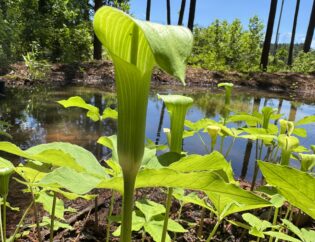

The Travels of William Bartram, Francis Harper’s Naturalist Edition,
Edited with commentary and an annotated index by Francis Harper
University of Georgia Press, Athens. 1998. 727 pages.
This book is annotated, and a mainstay of my environmental library. Written in a style of English weaned on the King James Bible, the prose may not be to everyone’s taste, but it pulls me into the era of the late Enlightenment. Both Botanist and Adventurer, William Bartram travels through the Southeast before the American Revolution, gathering botanical samples, both for his patrons and for his own horticultural purposes. He passed through Oglethorpe County not far from Beech Hollow Farm in Lexington, before Lexington was founded in 1800.
The job title “Botanist” sounds tame, even rather dull, but when I read about Bartram setting up camp on a bluff above a swamp, writhing with bellowing alligators in full mating display, the hair on my arms got all stand up and prickly. Later that same night Bartram had to climb a tree to avoid being eaten by one of those same alligators. Which is both amazing and terrifying. Yeah, there was a real monster under his bed.
Bartram logged thousands of miles of travels through a wilderness in the southeast, meeting and dealing with traders, Native Americans, witnessing trees over ten feet in circumference, and recording plants, flowers, fish and animals that few of us may ever meet. Sometimes his travels seem as if they were on another planet altogether.
This annotated edition allows the home-grown naturalist to cross reference the early discovery of Southeastern animal and plant species with today’s scientific nomenclature and geographic ranges. That is another reason, besides alligator tales, why I love this book so much!









